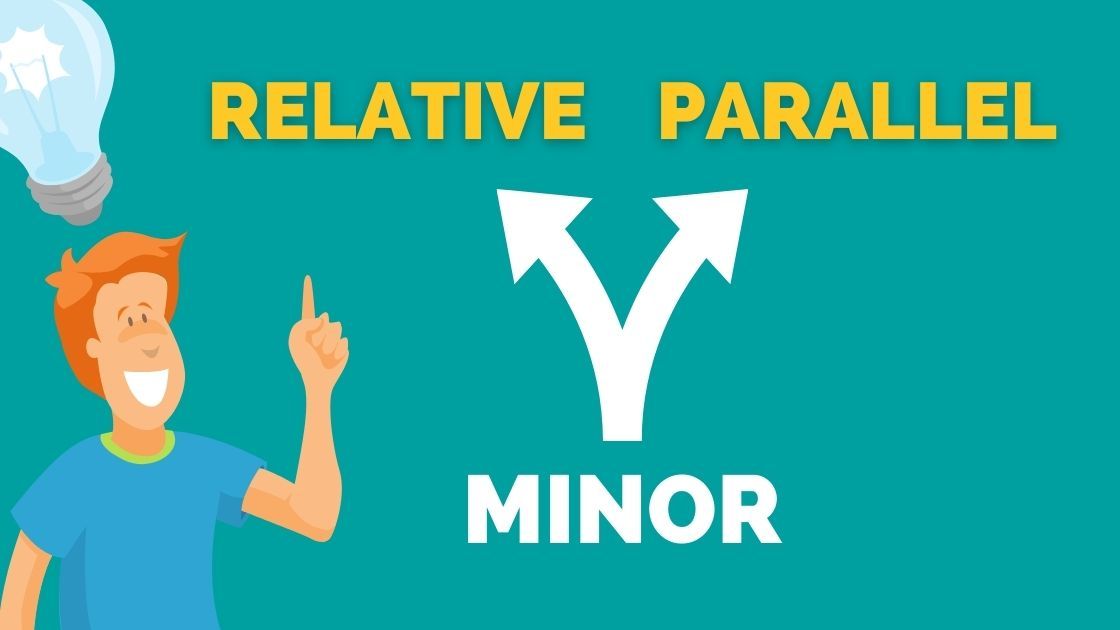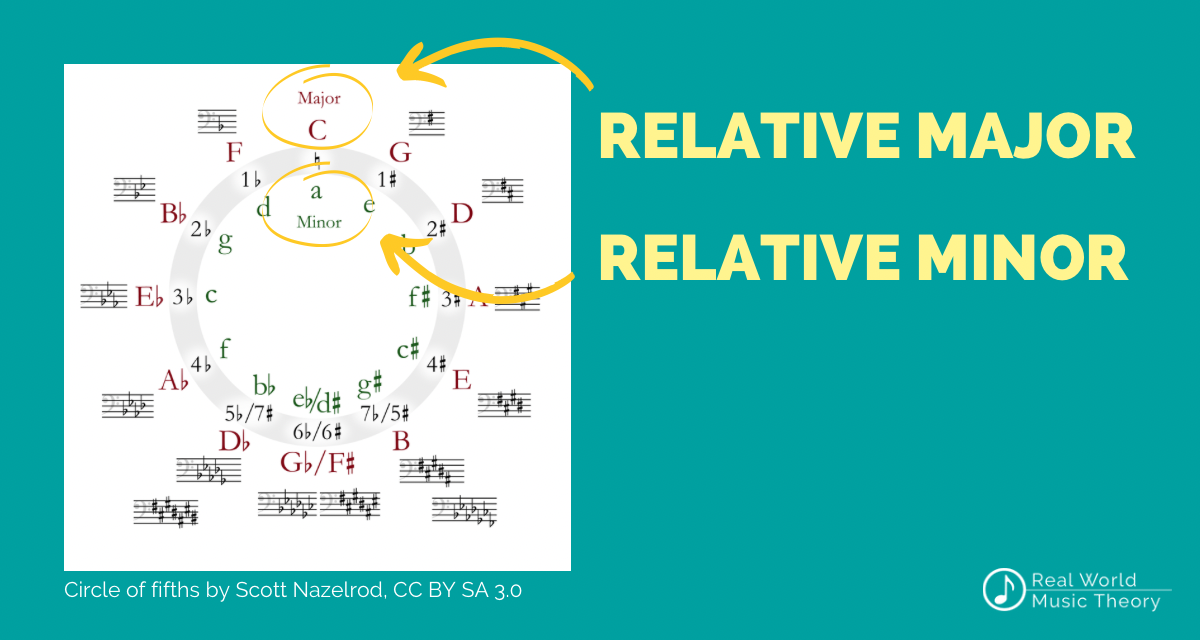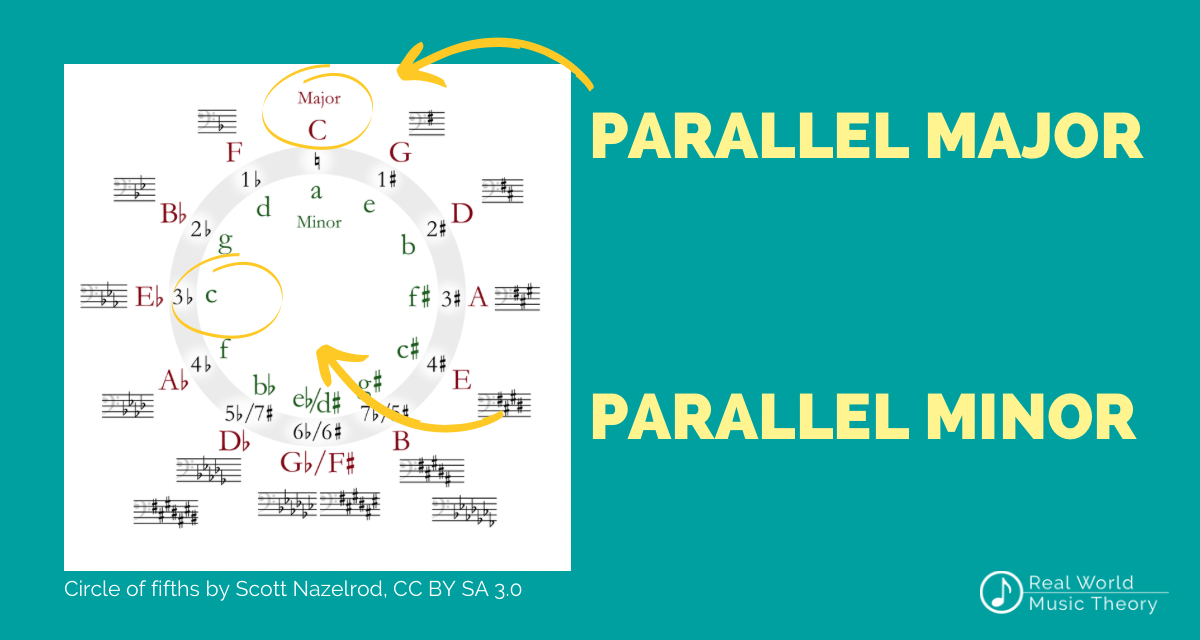Relative Minor and Parallel Minor EXPLAINED
Understanding the concept of relative and parallel keys is a must for any decent musician. Relative minor? Parallel major? These music theory terms are a lot easier than they might seem. Let's learn about relative and parallel keys now.

Understanding the concept of relative and parallel keys is a must for any decent musician. Relative minor? Parallel major? These music theory terms are a lot easier than they might seem. Let's learn about relative and parallel keys now.
Relative minor
Examples are easiest to understand:
- The relative minor of C major is A minor
- The relative minor of F major is D minor
- The relative minor of A major is F# minor
You can already see a pattern here:
The relative minor is always a minor third (or 3 half steps) below the major.
Though this is easy to remember, it doesn't yet explain, what relative minor is and why we need it. So let me ask the question: what do the major key and its relative minor have in common?
If you answered that they have the same accidentals or the same scale material, you were correct! The note material of C major is the same as the note material of A minor (i.e. all the white keys on a piano). The only difference between a major key and its relative minor key is the root: The root of C major is C, while the root of A minor is A.
In the circle of fifths, which orders all keys by their accidentals, C major and A minor actually share the same spot! And so do all other major and their relative minor keys.

If we look at relative minor as a chord (as opposed to a whole key), we can see that both the C major chord and the A minor chord belong to the other chord’s key. That means the A minor chord is included in the key of C major (it's the chord on the sixth scale degree) and the C major chord is included in the key of A minor (it's the chord on the third scale degree).
It's worth looking at relative chords a little closer. With a C major chord and an A minor chord side by side, we immediately see that they both share two of their three notes: C and E. If we extend these triads to four notes, they even have three notes in common: C, E and G. From this it's easy to understand how closely related relative chords are. They're so closely related that in functional harmony, a relative minor chord can take the place its relative major chord. Both C major and A minor play the same "harmonic function" (e.g. a tonic function in C major or a pre-dominant function in G major).
Try it and replace a major chord with its relative minor in any song. It almost always works, because the function of the chord didn’t change! Only its flavor is slightly altered. This is the basis of many tricks in music theory.
One such trick is to deceptively resolve a major cadence to the relative minor chord. This will sound somewhat surprising yet still satisfying. It creates a welcomed surprise without sounding too jarring. Try it for a few songs and replace the final cadential chord with its relative minor chord.
The famous 251 progression can also be explained with relative keys. A 251 progression is simply a full authentic cadence of 451 with the subdominant being replaced by its relative minor chord. Here is the example in C major:
F G C
Dm G C
Some scientists even believe the 251 progression was the original cadence that later developed into the classic 451 by replacing the first minor chord with its relative major (see next section)! This theory sounds convincing, because 251 not only has the functional progression of pre-dominant to dominant to tonic, but also has a sequence of falling fifths in the bass - one of the strongest forces in music theory. Anyway, we only need to remember: 251 and 451 are related via the magic of relative chords.
Relative major
Relative major is essentially the inverse of relative minor. If the relative minor of C major was A minor, then we say the relative major of A minor is C major. Here are a few examples again:
- The relative major of A minor is C major
- The relative major of D minor is F major
- The relative major of F# minor is A major
It's the same concept as with siblings: if Benny is Anna’s brother, then Anna is Benny’s sister. They're both relatives to each other.
The relative major is always a minor third (3 half steps) above the minor.
You can take everything you learned in the relative minor section above and apply it to relative major as well. The triads still have two of their three notes in common and both can still play the same function in a chord progression.
Relative major is just a way of describing the relative minor relationship from the other perspective. With parallel minor however, it gets a little more interesting again...
Parallel minor
Examples are easy to understand:
- C minor is the parallel minor of C major
- F minor is the parallel minor of F major
- A minor is the parallel minor of A major
You see the pattern:
The parallel minor always has the same root as the major.
That seems a lot simpler than it is. While the root stays the same in a parallel key relationship, the accidentals change dramatically. You can see this when looking at parallel keys in the circle of fifths:

You can view parallel keys as the cousins of relative keys: While relative keys keep all accidentals the same, but change the root, parallel keys keep the root the same, but change the accidentals.
Using parallel keys can sound more sophisticated due to the drastic move along the circle of fifths. It is certainly the more obvious sound compared to relative keys. So use parallel keys for the more impactful effect and relative keys to be more subtle.
Instead of just substituting a chord with its minor parallel chord (e.g. C major with C minor) many songs "borrow" chords from the entire parallel key. This is why you encounter non-diatonic chords like Eb major, F minor or Ab major in the key of C major quite frequently. Two examples might illustrate this:
Rock songs often use the "rock changes":
C Eb F C
It sounds familiar to our ears, yet these chords come from two different keys: C major (chords C and F) and C minor (chord Eb). While you could just say rock guitarists are lazy and just slide the major chord voicing up the fretboard 😂, the underlying music theory actually makes sense: The Eb chord is a borrowed chord from the parallel C minor key.
The minor plagal cadence is also a common progression using the parallel minor key:
F Fm C
I associate it mostly with endings of emotional ballads, but it can happen in any kind of song. Again, the Fm chord is borrowed from the parallel minor key of C minor.
If you want more examples of cool chord progressions commonly used in songwriting, check out this article (not yet published).
With parallel minor we tend to think more about the whole parallel key instead of single chords (as we do in relative relationships). This is in the nature of parallel minor, since it actually has different chords due to the different accidentals.
Parallel major
To make the relative and parallel realm complete, we still have to talk about parallel major. Here are a few examples:
- C major is the parallel minor of C minor
- F major is the parallel minor of F minor
- A major is the parallel minor of A minor
Pretty straight forward, once you understood parallel minor 😁:
The parallel major always has the same root as the minor.
Again, like with parallel minor, the accidentals of the parallel major key change. Parallel major is just the reverse of parallel minor.
I have seen less deliberate use of parallel major chords or keys in songs. One common pattern in songs is the major dominant chord in a minor key:
G Cm
While this is a valid case, the dominant major is often better explained with harmonic minor, which adds the guide tone of B to the C minor tonality. As soon as you add options like 9ths to the dominant chord, the interpretation as harmonic minor often works better.
I have seen less use of the parallel major key in actual songs compared to parallel minor or relative keys. Nevertheless you should know about this twin of parallel minor to extend your harmonic choices when writing in a minor key. And if you know any songs that use parallel major, please send me a message with the song!
Chord or key?
You might have noticed that we can talk about relative/parallel keys and relative/parallel chords. Sometimes the distinction is important, sometimes it's not - but I thought clarifying this matter briefly does not hurt.
Talking about the relative minor key of C major doesn't give us any new chords to choose from. The chords of A minor (the relative key) are exactly the same as those of C major. If we apply the concept of "relative" to single chords, however, we get a possible substitution chord for each major chord in the key. So with "relative" we mostly think about relative chords.
Talking about the parallel minor key C major, however, gives us a whole set of shiny new chords we can borrow! So with "parallel" we mostly talk about the whole key instead of single parallel chords. Simply replacing a major chord by its minor parallel chord can certainly work (like in the plagal cadence Fm C), but in actual songs it is far more common to borrow other chords from the entire parallel key (like C Eb F).
In practice most people don't bother to distinguish strictly between relative/parallel keys or relative/parallel chords. And that is fine.
Sometimes it pays to combine the concept of a parallel and relative chords to pick the right chord from a parallel key. For example substituting a borrowed Eb major chord for a C major chord can be explained in these two steps: First replace C major with its parallel minor chord C minor, then replace C minor with its relative major chord Eb.
When you watch my videos, you can occasionally see me use this two-step-explanation to analyze a chord progression 😁.
Borrowing chords
An important topic with parallel keys is the idea of borrowing chords. Borrowing a chord means to widen your set of harmonic choices by also using ("borrowing") chords from the parallel key. In C major for example, you would only have seven chords to choose from (aka diatonic):
C major, D minor, E minor, F major, G major, A minor, B diminished
But once you also add all possible chords from the parallel minor key (C minor in that example), you get seven more chords to choose from:
C minor, D diminished, Eb major, F minor, G minor, Ab major, Bb major
Now you have 14 (!) chords to harmonize your melodies - that's twice of the chord material you would normally use in a diatonic setting.
So instead of harmonizing a melody note G with the chords C, Em or G, you can also harmonize it with Cm, Eb or Gm. We already saw the example of the "rock progression" above. The awesome backdoor progression is another example of borrowing chords from parallel minor.
“P” stands for “relative” !?
If you are a non-native English speaker or you have been trained in functional harmony, you might be surprised that the abbreviation for "Tonic relative" chord is Tp!? This comes from the German origins of functional harmony and it can be pretty confusing: "parallel" in German means "relative" in English 😳. Check out this interesting fact in my article Parallel or Relative minor? (coming soon).
Summary
Understanding relative and parallel keys is a basic skill for any decent musician. Now you have a thorough understanding of the two concepts "relative" and "parallel" as well as their application to whole keys or single chords.
While a using chords from the relative key does not change the sound a lot, borrowing chords from the parallel key has more drastic effects. This is because of relative keys having the same accidentals (and thus the same chords) as their relative counterpart (e.g. C major and A minor). The chords of A minor are still diatonic to C major (e.g. the chords Em or F). Parallel keys however have different accidentals than their parallel counterpart! They essentially shift you around the circle of fifths by three steps (e.g. C major (no accidentals) and C minor (3 accidentals).
To practice the concept of relative chords and keys, try to substitute an occasional chord with its relative counterpart. Take your favorite song or one of your own compositions. Randomly replace a few chords and listen to the effect.
To practice the concept of parallel chords and keys, try to substitute the occasional chord with any chord you borrow from the parallel key. Again take your favorite songs or any of your own pieces. Get used to the sound and the effects you can achieve.
And now pat yourself on the shoulder for learning this new concept and be eager to apply it in your future songwriting and playing! Most of all: have fun and make awesome music! 🎉